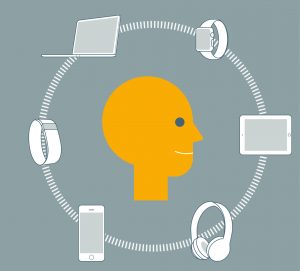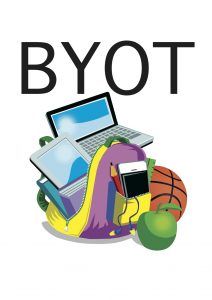Mal Lee and Roger Broadie
This seemingly mundane management issue, that most educators view as just that, challenges the very nature of schooling.
Are schools in democracies places where the state compels a compliant youth to learn what and how government believes is appropriate, or are they organisations that assist an increasingly digitally empowered young ready themselves for life, work and learning in a rapidly evolving, often uncertain, digitally based, connected and socially networked world?
Are they physical institutions that must unilaterally control every aspect of learning of an appropriately compliant, subservient youth within the school walls, or are they learning organisations that work with all the ‘teachers’ of the young in assisting provide an apt, balanced, holistic and largely individualised education?
The litmus test to these questions is whether the school believes it must unilaterally control the choice and use of the personal technology within the school walls, or whether it is willing to trust and empower its students, and give them the freedom and responsibility to use their own suite of digital technologies astutely in all facets of their learning, including that within the school.
Educators as a group don’t appear to have grasped how important it is for the world’s young to be digitally empowered, and to learn from naturally using that capability. It is akin to owning one’s first car, but much more. It is not simply having one’s own highly sophisticated, immensely powerful technologies. It is having the agency to use those technologies largely as one desires, and taking control of one’s use and learning with those technologies. And being able to do so very early in life, before they can read and write, and to do so 24/7/365 lifelong.
It is an agency enjoyed by near 70% of the world’s young (ITU, 2017), (UNICEFF, 2017) – albeit outside the school walls, with the trend line moving at pace to near universal digital connectivity.
UNICEF’s 2017 study rightly observed:
Digital technology has already changed the world – and as more and more children go online around the world, it is increasingly changing childhood (UNICEF, 2017, p1).
Until schools and their governments appreciate that digitally empowered young are the new normal, and are willing to adjust their ways, to relax their control, to trust and empower those young people to use their ‘own’ kit astutely and creatively in class schools will never normalise the use of the digital, nor play any meaningful role in assisting the nation’s young grow being digital.
Schools will remain doing the digitalwithout ever being digital.
It is appreciated that won’t unduly worry many teachers and governments.
But it does means most schools developmentally will move into a state of evolutionary equilibrium, unable to evolve as digitally mature organisations which can continually transform their operations and accommodate the accelerating digital evolution. Daily they will lag ever further behind the young’s everyday learning with the digital outside the school; their teaching becoming increasingly dated and irrelevant.
The national implications are considerable, particularly when the research (Lee and Broadie, 2018) suggests 70% – 80% of the nation’s schools show no inclination to forgo their control. Most will thus do little or nothing to enhance the capability of the vast human resource digital economies have in their digitally connected young.
The moment schools decide they – and not the students – must choose the personal technology the young will use in the classroom they forgo any hope of assisting grow the nation’s young being digital, having the digital invisibly underpin all school learning, of moving the school from an analogue to digital operational mode, and having it join and assist grow a networked society.
The decision relegates the school to the digital backwater.
In announcing its unilateral control of the technology, the school is proclaiming that it intends to maintain its traditional ‘control over’ ways, and that any use of the digital must fit within those ways. It is saying to the students and their families that not only do we know best, but we distrust you, are not willing to empower you, and we don’t value or recognise the lead role you have played – and are playing – in learning with the digital.
It is saying being digital is unimportant, and that a digitally empowered young – working with their teachers – are incapable of using the digital astutely and creatively in enhancing their learning in all areas of the curriculum, at all stages of learning.
Schools and governments worldwide seemingly don’t appreciate the very powerful messages they send when they make seemingly innocuous management decisions about the control of the digital technology.
It is imperative as a school leader you understand, and are aware of the wider educational and national ramifications of the decision.
The critical conditions.
Five conditions are critical to the sustained natural growth in learning with the digital (Lee, Broadie and Twining, 2018).
- Ready access to the personal, preferably mobile technology
- Digital connectivity
- Support, empowerment and trust
- Largely unfettered use
- Self-directed learning, able to collaborate when desired (Lee, Broadie and Twining, 2018).
Those five, closely related conditions go a long way to explaining why over two billion young (ITU, 2017), (UNICEF, 2017) are digitally connected, digitally empowered and have normalised their everyday use of the digital, and why so few schools have yet to do so.
If – and we appreciate it is a huge ‘if’ that pertains to the nature of schooling you wish to provide – your school wants to normalise the use of the technology, assist grow the students being digital, and vitally use the digital to enhance all their school learning it needs to understand why the digitally connected families – and the exceptional schools – have succeeded, and why most schools have failed.
“Own’ kit and connectivity
Critical is that digitally empowered students can use their ‘own’ suite of digital technologies largely unfettered within the school walls, and have ready connectivity.
That carries with it the school’s and teacher’s appreciation of how best to build upon that ownership to grow the learners and their learning. It entails a willingness to trust students to use in their everyday school learning the technologies they already use 24/7/365, the need to empower them, recognise, to value and build upon the students being digital, while understanding how they can take advantage of that capability in their teaching.
It obliges the school to understand this is a digitally empowered generation, with a digital mindset, ever rising expectations, who have long taken charge of their learning with the digital, who will do so lifelong, who have grown being digital by naturally using the apt technologies in near every facet of their lives and knowing how best to take advantage of that digital skillset.
The schools can, if they desire complement and add value to the students being digital, but only if they are prepared to support already empowered students use of their own kit in the ways they are accustomed.
Understand it is not about the technology per se.
It about how each of us in a digitally connected world, from around the age of three through to death, can control the use of, and learning with that suite of continually evolving technologies.
It is about being able to do largely what we want, when and how we want.
None who are digitally empowered tolerate ‘big brother’ telling them what they can and can’t do with their personal technology. That intolerance is amplified with a young that have only ever known a digital world, who have long taken charge of its everyday use everywhere except within the school, that have successfully individualised its application and which are likely to be more digitally proficient with the current technologies than most of their teachers.
While it might come as a surprise to many, educators need understand the world’s digitally connected young will only use the teacher directed, structured, linear approach to learning with the digital used by schools when compelled.
It is antithetical to the all-pervasive, highly integrated laissez faire approach they use every day.
- ‘Control over’ schools
History affirms (Lee and Broadie, 2018) that when the schools insist on tightly controlling the student’s choice and every use of the digital it will do little or nothing to enhance their being digital, their learning how to learn with the technology or crucially their learning in all areas of the curriculum.
All it does is reinforce the traditional analogue mode of schooling, its hierarchical operations, its unilateral control of teaching and largely closes the door for digitally empowered young to use their very considerable, digital capabilities and digital tool kit in their school learning.
Under the ‘control over’ model the ‘experts’ invariably decide on an ‘appropriate’ device, the operating system, software, apps, set up, storage, maintenance arrangements, upgrades and replacements. Their focus is the group, on all students using the same set up, with scant if any regard given to personalising the set up or individualised learning. It is the technology that matters not the learner. The ‘experts’ decide on the school’s ‘acceptable use policy’ (AUP). And how the technology will be deployed, used and monitored. Significantly they also decide – for the students and teachers – which digital technology will not be allowed; from the mid 1990’s banning most of the personal digital technologies and online services the students used 24/7/365 outside the school (Lee and Broadie, 2018).
In most schools, particularly at the secondary level, the technology will likely only be used within specific ‘computing’ or ‘ICT’ classes.
Net connectivity is tightly controlled and censored. Teacher permission is needed, and usually only allowed when the teacher thinks it is appropriate.
The focus is insular, on that happening within the school walls, within its operating hours, less than 20% of the young’s annual learning time.
Digitally empowered students and parents have no say in the technology used, the curriculum, the teaching or the assessment, they simply complying with the experts and teachers dictates.
- Student choice schools
In letting the students use their own suite of digital technologies the school – perhaps unwittingly – takes a significant step towards adopting a more inclusive, networked mode of schooling, that seeks to genuinely collaborate with its students, families and community in providing an apt education for an ever evolving digitally connected world.
By distributing its control of the resourcing and teaching, and sharing it with the individual learners and their families the school is readying the move from an analogue to digital mode of schooling.
It positions the school and its teachers – at no cost – to continually work in class with students using the cutting-edge or near cutting-edge technology, and to largely overcome the growing technology lag evident in the ‘control over’ schools.
It allows the students to continue to direct much of their learning with the digital, to use the tools they know and use 24/7/365, that they have tailored for their learning style and to use those parts of their kit they – and not the experts – believe will best do the job at hand.
It provides teachers the freedom to work closely with their students, to take on their ideas, to be flexible and when is all is working well to step to the side and let the learners direct their learning.
In working with the student’s technologies, the teachers quickly recognise the individual learner’s interests and capabilities, able to tailor their teaching accordingly. Importantly it also provides the school with a bridge to the families, providing an insight into the capabilities and resources of each, making it that much easier to support and add value to the efforts of the families.
In exploring the work of those exceptional schools (Lee and Levins, 2016) that for some time have encouraged their students to use their own technologies the authors were struck by their willingness to genuinely collaborate with their families, to value and build on the out of school learning, to remove from the curriculum material already learned and to integrate the use of the digital in all areas of learning, and all school operations.
Everything appeared so natural. No one thought twice about ceasing to teach digital proficiency and simply building upon the student’s learning.
That said while the use of the digital was central to all operations, and Net access was appreciably greater than the ‘control over’ schools, connectivity was primarily through the school’s network, and as such appreciably more constrained than outside the school.
It was also evident – a reality confirmed by the case study follow up – all the schools studied were aware that at this point in the history their efforts to vary the mode of schooling were dependent on the current head, and that a change in the principalship or government could see the school revert to its traditional form, with years of effort wasted.
Conclusion
Within the developed nations of the world virtually all the young are digitally connected, and empowered, having only ever known a digital and socially networked society.
Their upbringing has been – and continues to be – within digitally connected families, with ready access to all manner of highly sophisticated personal digital technologies, and increasingly powerful, tightly integrated digital ecosystems.
From very early in life they have been provided their ‘own’ kit, connectivity and trusted, empowered and supported to use that technology largely unfettered.
By three most children born into digitally connected families will be digitally empowered, and have begun the lifelong journey of taking charge of their use and learning with the digital, understanding how to learn with it, and naturally and confidently growing their being digital.
They are never going to relinquish that power.
While ever schools refuse to attune their ways to the new reality the young, with the support of their digitally connected families, will continue grow their being digital outside the school walls, continually evolving their capability, and daily widening the gap between the in and out of school use of the technology.
Digitally empowered young are never going to going to embrace a highly structured ‘control over’ approach to learning with the digital where they are disempowered, devalued and subservient.
Rather as a vast, growing and evermore powerful cohort they will likely increasingly expect society and its schools to accommodate the changing world, and to attune their ways and adopt a mode of schooling where digitally empowered young normalise the use of their personal technologies.
As a school leader contemplating the way forward appreciate you are deciding on the desired nature of the schooling, and not simply a minor management issue.
Bibliography
- ITU (2017) Measuring the Information Society Report 2017 Volume 1 Geneva International Telecommunications Union – https://www.itu.int/en/ITU-D/Statistics/Pages/publications/mis2017.aspx
- Johansen, S.L, Larsen, M.C and Ernst, M.J (2016) Young Children and Digital Technology– Aarhus University, Aalborg University, Danish Media Council for Children and Young People, February, 2016 – http://www.aau.dk/digitalAssets/201/201213_national-report_2015_denmark_proofread-2-.pdf
- Lee, M and Levins, M (2016) BYOT and the Digital Evolution of Schooling Armidale Douglas and Brown – http://douglasandbrown.com/publications/
- Lee, M and Broadie, R (2018) Digitally Connected Families. And the Digital Education of the World’s Young, 1993 – 2016, Armidale, Australia, Douglas and Brown – http://douglasandbrown.com/publications/–
- Lee, M, Broadie, R, and Twining, P (2018). Your Kids Being Digital. A Guide for Digitally Connected Families.Armidale Australia
- Meeker. M (2018) Internet Trends 2018Kleiner Perkins May 30, 2018 – http://www.kpcb.com/internet-trends



